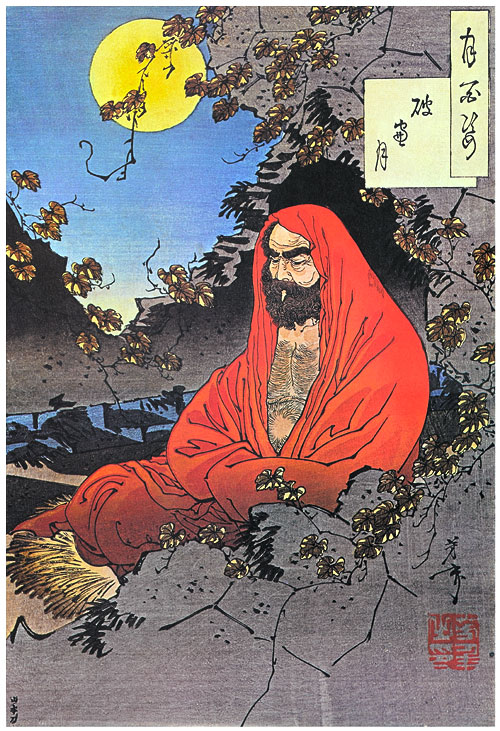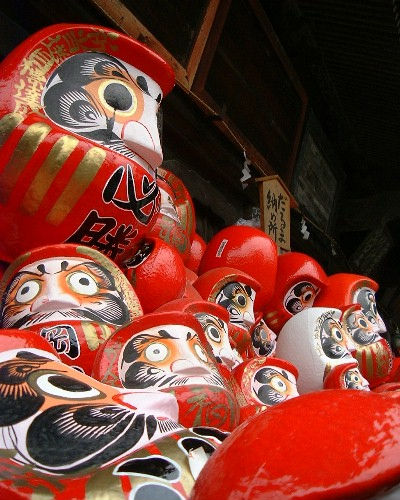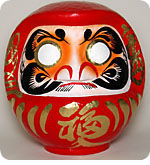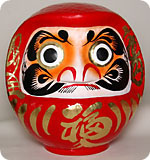
HISTORY OF DARUMA
The Daruma doll (達磨 daruma), also known as a Dharma doll, is a hollow, round, Japanese traditional doll modeled after Bodhidharma, the founder of the Zen sect of Buddhism.
Bodhidharma was a Buddhist monk who lived during the 5th/6th century AD. He is traditionally credited as the transmitter of Ch'an (Zen) to China. Little contemporary biographical information on Bodhidharma is extant, and subsequent accounts became layered with legend.
According to one tradition, Bodhidharma gained a reputation for, among other things, his practice of wall-gazing. Legend claims that he sat facing a wall in meditation for a period of nine years without moving, which caused his legs and arms to fall off from atrophy.
Another popular legend is that after falling asleep during his nine-year meditation he became angry with himself and cut off his eyelids to avoid ever falling asleep again.
These dolls, though typically red and depicting a bearded man (Dharma), vary greatly in color and design depending on region and artist.
Though considered an omocha, meaning toy, Daruma has a design that is rich in symbolism and is regarded more as a talisman of good luck to the Japanese.
Daruma do lls are seen as a symbol of perseverance and good luck, making them a popular gift of encouragement. The doll has also been commercialized by many Buddhist temples to use alongside goal setting.
lls are seen as a symbol of perseverance and good luck, making them a popular gift of encouragement. The doll has also been commercialized by many Buddhist temples to use alongside goal setting.
It is believed that the Daruma figurine then originated from this region when the ninth priest, Togaku, found a solution to handle the constant requests of the parishioners for new charms.
The charms were always given with an effectiveness of one year, so the people required new ones every year. He solved this by entrusting them with the making of their own Daruma charms near the beginning of the Meiwa period (1764–72).
The temple made wooden block molds for the people to use.
The peasants then used these molds to make three-dimensional papier-mâché charms.
How to use:
- When buying a Daruma, its eyes are blank.
- You must then make a wish and paint one of the Daruma's eye (left or right).
- When your wish is realised, you can then paint the second eye as a sign of accomplishment.





Daruma come in various sizes:

DARUMA - HOW IT'S MADE
The origin of Daruma can be traced back to approximately 200 years ago when Tomogoro Yamakake first created Daruma dolls. The method of creating Daruma dolls was kept as a family secret for 80 years.
However, approximately 120 years ago, many people in Toyo-oka area started producing Daruma dolls. The Daruma dolls created by Toyo-oka people were being sold at the market of Nanakusa Festival, which has been held since Shorinzan Darumaji was built.
Darumas are still usually made of papier-mâché, have a round shape, are hollow and weighted at the bottom so that they will always return to an upright position when tilted over. In Japanese, a roly-poly toy is called okiagari, meaning to get up (oki) and arise (agari).
This characteristic has come to symbolize the ability to have success, overcome adversity, and recover from misfortune In Japanese popular culture on cards, banners and books, Daruma is often illustrated alongside the phrase "Nanakorobi Yaoki", translated to mean "seven times down, eight times up".
How to draw eyes:
It is said that painting the left eye of a Daruma doll first is the correct way.
There are a few reasons to support this idea. When a person has no equal, it is described in Japanese that there's no one who stands on that person's right. Also, left-side seats are considered higher in rank in a seating arrangement. However, there is no correct order of painting eyes of a Daruma doll. Drawing eyes signifies "opening of a Daruma doll's mind's eye", not just filling in the blank eyes.
To paint Daruma's eyes is to put its soul into it. In the olden days, round, wide-open eyes were painted by the manufacturer and sold. In modern times, buyers of Daruma dolls do their own painting.





